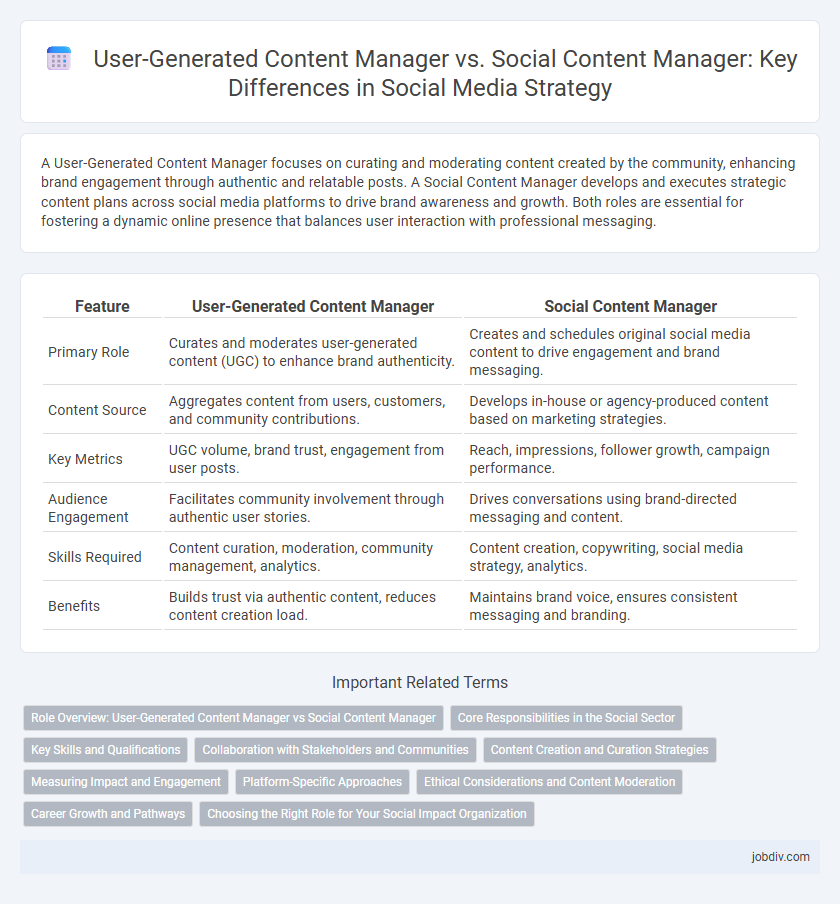A User-Generated Content Manager focuses on curating and moderating content created by the community, enhancing brand engagement through authentic and relatable posts. A Social Content Manager develops and executes strategic content plans across social media platforms to drive brand awareness and growth. Both roles are essential for fostering a dynamic online presence that balances user interaction with professional messaging.
Table of Comparison
| Feature | User-Generated Content Manager | Social Content Manager |
|---|---|---|
| Primary Role | Curates and moderates user-generated content (UGC) to enhance brand authenticity. | Creates and schedules original social media content to drive engagement and brand messaging. |
| Content Source | Aggregates content from users, customers, and community contributions. | Develops in-house or agency-produced content based on marketing strategies. |
| Key Metrics | UGC volume, brand trust, engagement from user posts. | Reach, impressions, follower growth, campaign performance. |
| Audience Engagement | Facilitates community involvement through authentic user stories. | Drives conversations using brand-directed messaging and content. |
| Skills Required | Content curation, moderation, community management, analytics. | Content creation, copywriting, social media strategy, analytics. |
| Benefits | Builds trust via authentic content, reduces content creation load. | Maintains brand voice, ensures consistent messaging and branding. |
Role Overview: User-Generated Content Manager vs Social Content Manager
The User-Generated Content Manager specializes in curating, moderating, and leveraging content created by a brand's audience to boost engagement and authentic brand representation. In contrast, the Social Content Manager is responsible for strategizing, creating, and scheduling original content across social media platforms to drive brand awareness and marketing goals. Both roles are critical in managing digital presence but differ primarily in content origin and strategic focus.
Core Responsibilities in the Social Sector
A User-Generated Content Manager focuses on curating, moderating, and leveraging content created by community members to enhance engagement and authenticity on social media platforms. In contrast, a Social Content Manager prioritizes creating and scheduling original branded content, managing campaigns, and analyzing performance metrics to drive brand awareness and audience growth. Both roles require expertise in social media trends, but the User-Generated Content Manager emphasizes community interaction while the Social Content Manager centers on strategic content planning and execution.
Key Skills and Qualifications
User-Generated Content Managers excel in community engagement, content moderation, and data analysis, requiring strong skills in audience insights and platform-specific moderation tools. Social Content Managers prioritize strategic content creation, brand consistency, and campaign management, emphasizing expertise in content planning, SEO, and multimedia production. Both roles demand proficiency in social media analytics and a deep understanding of digital marketing trends to maximize audience reach and engagement.
Collaboration with Stakeholders and Communities
A User-Generated Content Manager excels in fostering collaboration by actively engaging communities to create authentic content, ensuring stakeholder feedback shapes community-driven narratives. In contrast, a Social Content Manager coordinates closely with marketing teams and external partners to curate branded content that aligns with strategic goals. Both roles require seamless communication across stakeholders, but the User-Generated Content Manager prioritizes community involvement while the Social Content Manager emphasizes brand consistency.
Content Creation and Curation Strategies
User-Generated Content Managers prioritize sourcing and curating authentic content from audiences to foster brand loyalty and community engagement, leveraging fan contributions as a core content strategy. Social Content Managers focus on creating and scheduling original, platform-specific posts that align with marketing goals and audience demographics to drive consistent brand messaging. Both roles require strategic content planning, but the former emphasizes organic, user-driven content, while the latter centers on brand-controlled narrative and campaign execution.
Measuring Impact and Engagement
User-Generated Content (UGC) Managers focus on leveraging authentic consumer contributions to enhance brand credibility and foster community engagement, utilizing metrics such as share rates, comment sentiment, and conversion tracking to measure impact. Social Content Managers develop and distribute curated brand narratives across platforms, analyzing engagement rates, reach, and audience growth to optimize content performance. Both roles prioritize data-driven approaches but differ in content origin, with UGC Managers emphasizing user interaction patterns and Social Content Managers focusing on strategic brand messaging efficacy.
Platform-Specific Approaches
User-Generated Content Managers specialize in harnessing audience-created posts to boost engagement on platforms like Instagram and TikTok, emphasizing community interaction and authenticity. Social Content Managers develop tailored content strategies for each social media channel, such as Facebook's algorithm-friendly posts or LinkedIn's professional updates, to optimize reach and brand messaging. Both roles require platform-specific insights, but the former prioritizes organic user interaction while the latter focuses on curated brand storytelling.
Ethical Considerations and Content Moderation
User-Generated Content Managers prioritize ethical considerations by enforcing community guidelines and moderating submissions to prevent harmful or inappropriate material. Social Content Managers focus on creating and curating brand-aligned content while ensuring compliance with platform policies and maintaining audience trust. Both roles require balancing creative freedom with ethical responsibility to foster a safe and engaging social environment.
Career Growth and Pathways
User-Generated Content Managers specialize in curating and moderating community-driven content, offering career growth opportunities in community management, content strategy, and digital marketing analytics. Social Content Managers focus on creating, scheduling, and optimizing brand-driven content across social platforms, leading to pathways in brand strategy, digital advertising, and social media leadership roles. Both roles provide valuable skills in audience engagement and data analysis, crucial for advancing to senior roles such as Social Media Director or Chief Marketing Officer.
Choosing the Right Role for Your Social Impact Organization
User-Generated Content Managers specialize in curating and moderating authentic community contributions, ensuring brand voice consistency while fostering audience engagement. Social Content Managers develop strategic content plans, managing posts across platforms to maximize reach and drive organizational goals. Selecting the right role depends on prioritizing either authentic user interaction or strategic content dissemination to enhance your social impact organization's effectiveness.
User-Generated Content Manager vs Social Content Manager Infographic

 jobdiv.com
jobdiv.com